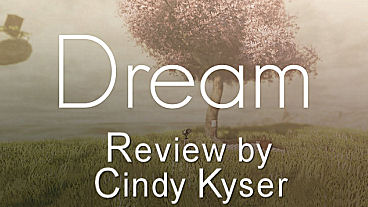
Dream Review
From an artistic viewpoint, Dream is magnificent, but plan to do an inordinate amount of traveling as the game world is (in my opinion) unnecessarily vast.







Genre: Adventure/Exploration
Release date: July 31, 2015
Hypersloth is an indie game studio based in the United Kingdom. Founded in 2012 by Ashley Stancill, Lewis Bibby and Samuel Read, this small team has spent over three years turning their own dreams into a virtual reality. Described as a “a first person atmospheric exploration game,” Dream is inspired by the gameplay of Kikiyana’s 2004 release Yume Nikke (Dream Diary) and the narrative elements of Dear Esther, which was released in 2012 by The Chinese Room.
The world of Dream is experienced through the mind of Howard Phillips, a recent college graduate who has yet to decide what he wants to be when he grows up. His life is in a holding pattern: he has moved home, is coming to terms with the death of a beloved uncle and is trying to find his own path. Despite the banalities of his “real life,” his subconscious is working overtime as evidenced by his dreams.
When awake, Howard’s world is restricted to his residence. When sleeping, however, he dreams of a hub with gateways to different worlds. He returns to his bedroom either by waking or by traveling back through specific dream “gates.” Hypersloth has carried this one step further and emulates a “wake up” by Howard each time the game is exited.
The game world of Dream has three primary areas. Your first point of access is into “Guardian Quandary” – a vast desert wilderness. Upon completion of tasks there, you gain access to the offices of Augmented Realities and begin the “Soul Appraisal” segment. Finally, you are able to enter the Ultinsula island resort through the “Ancient Morality” gate. Within each world are puzzles, one or more white gateways into sub-dreams and a black gateway into a nightmare. Throughout your journey, you encounter floating bits of paper with interpretations of various dream elements. You collect a small number of inventory items which can be used along the way. If you’re paying attention, you may also find numbered Dream “pages.” Since both inventory objects and pages are displayed on pedestals in the dream hub, you are able to get a sense of your progress (or lack thereof) by counting the number of empty slots.
From an artistic viewpoint, Dream is magnificent. The graphics are stunning and environmental effects such as smoke, shooting stars and lighting add to a sense of virtual reality. You play in the first-person so when you look down, you see Howard’s feet and pajamas. When you hold something, you see his hand. When you pass a mirror, you see his reflection. Throughout the game, you are privy to Howard’s inner musings through narration by Jonathan Keith. Add in an original sound track by Normal Legies coupled with directional sound effects, and you have an immersive experience that is, at times, startling and surprising.
The interface is refreshingly simple. With a mouse to control direction and a few keys for walking, running, and crouching, you can navigate with ease. Inventory is selected with a keystroke (or mouse wheel turn) and used with another key. Items in the environment are accessed by clicking your mouse when a ‘floating hand’ cursor appears.
The puzzles are diverse and complex. There are mazes, conveyor belts, telephones, visual challenges and stairways to nowhere. The objective of each puzzle is rarely obvious and part of the discovery is figuring out what you are supposed to do. With few exceptions, most are solved by mechanical manipulation rather than by finding clues or patterns in the game world. Be prepared to play with a pencil and paper, as several require some serious problem-solving. Since puzzles are a prerequisite to entering new areas of Dream and cheating is not an option, you have no choice but to nut up and push through.
For those gamers who focus on the journey rather than the destination, the expansive landscapes of Dream are a reward unto themselves. There is much to see but not as much to do. Most of the environment is “view-only” and items that can be examined or selected are few and far between. For me, the desert of “Guardian Quandary” was endless; a labyrinth of twists and turns that all looked the same. Despite a few trail markers and a less-than-helpful map, I spent hours trying to navigate to unknown points of interest. Once I reached a destination, my chances of getting back to it with ease were slim to none.
Dream has an auto-save feature so I assumed that exiting and later resuming the game would return me to my ‘save’ point. Not so. Howard wakes up when you exit the game which means that you are returned to his bedroom. You then have to reenter the dream hub and attempt to get back to your previous position. In the office building and island resort, this just requires traversing long distances. In the desert, it’s like restarting a maze from the beginning. Although completed puzzles are saved, any that are in process at the time of exit have to be restarted. For especially lengthy puzzles, I found myself staying up much later than planned because I was not about to lose progress by turning off my PC and going to my own dream world.
Plan to do an inordinate amount of traveling in Dream, as the game world is (in my opinion) unnecessarily vast. You will also expend a lot of effort clicking on objects that are not available for examination. This, coupled with the requirement that you be perfectly positioned to interact with something, means that time must be spent trying to determine if an item is truly “view-only” or if you are just standing in the wrong place. This is especially problematic during a timed puzzle that requires you to find and interact with specific objects in sequence. My time kept running out as I shifted back and forth, right and left, trying to trigger the elusive “floating hand”’ cursor so that I could click and move on.
If you have a lot of time on your hands and enjoy wandering for the sake of exploration, then you’re a likely candidate for the Dream fan club. If, on the other hand, you’re a late night gamer with a day job and want to move with purpose, then Dream may not be for you. As an aside, I read an article that mentioned it was a short game that could be completed in 6 to 9 hours. Wow! When I compare this to the time I spent playing Dream, I can only come up with two possibilities: (1) that writer played a different game, or (2) perhaps I am less smart and more navigationally challenged in the dream world than I am in real life!
After more hours than I can count, I have been awarded Steam Achievements for (1) completing all 3 Dream Acts; (2) completing all 3 nightmares and (3) experiencing the “best” game ending. However, my own dream hub has a couple of empty pedestals and four empty “page” holders. I also know that there are at least two sub-dreams that I was never able to access. This indicates that there is still more for me to do in Dream. Since game play is non-linear, the fact that I have viewed the ending does not prevent me from reentering Howard’s mind and continuing to explore. At this moment in time, however, the thought of retreading all those empty landscapes in order to find a couple of missing items and hidden gates is just too painful to contemplate. I will save that for another night.
|
+ Stunning graphics and immersive soundtrack
+ Complex and diverse puzzles
+ Many hours of open-ended gameplay
– Way too much traveling required
– Auto-save feature results in loss of location and restarts puzzles in progress
– More “seeing” than “doing” |

|
Processor: 3.0 GHz Dual Core Processor
Memory: 4 GB RAM
Graphics: Shader Model 3 compliant graphics cards (GeForce GT 520/Radeon HD 3850 and above)
Hard Drive: 5 GB available space

Leave a Reply